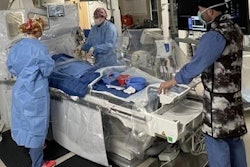A group in Japan has developed and tested an elastic x-ray shield made by embedding bismite particles in porous polyurethane, and suggests the new shielding material could provide more comfortable radiation protection.
“It is expected that this x-ray shielding material will lead to the development of various radiation protectors used for clinical applications,” wrote corresponding author Hiroaki Hayashi, PhD, of Kanazawa University in Kanazawa, in a study published December 16 in Medical Physics.
Hospitals have guidelines on the use of radiation protective procedures, and various x-ray shields are used to reduce unwanted exposure to patients and staff, yet most shields are in the form of sheets and lack elasticity, which limits their effectiveness in shielding areas with movement, such as the thyroid, the authors explained.
To overcome this limitation, the group developed a novel elastic x-ray shield, and described their methodology and the testing of the shield in the study.
In brief, the x-ray shield was developed through a process of embedding Bi2O3 particles from bismuth oxide (Bi2O3), compounds found in the element bismuth, into porous polyurethane. Porous polyurethane with a thickness of 10 mm was dipped into a solution of water, metal particles, and chemical agents. Then, it was air-dried to fix the metal particles in the porous polyurethane.
Using this process, the researchers fabricated 13 investigational x-ray shields in which Bi2O3 particles were embedded at various mass thicknesses ranging from 585 to 2493 g/m2. To determine the performance of the shields, the researchers primarily focused on changes in Dose Reduction Factor (DRF), a ratio between the dose received without any shielding and the dose received when shielding is applied.
Of the 13 prototypes, an elastic shield with small pores containing 1,200 g/m2 of the metal elements exhibited the most well-balanced performance. The DRF was approximately 80% for a typical diagnostic x-ray acquired at 70 kV, according to the findings.
“It was verified that an elastic x-ray shield that offers an appropriate reduction in radiation exposure can be produced by embedding Bi2O3 particles into porous polyurethane,” the researchers wrote.
Moreover, the elasticity of the shield was only 30% lower than that of the original base material, demonstrating that the material retained its flexibility, they added. Ultimately, to take advantage of the proposed shield’s elasticity, the group noted that they have plans to develop other shields that can cover movable areas.
“If an x-ray shield having new functions can be developed, it would open up the potential for broader applications of x-ray shields not only in CT imaging, but also in the fields of general x-ray imaging, dental radiology, [and] mammography,” the group concluded.
The full article can be found here.



















